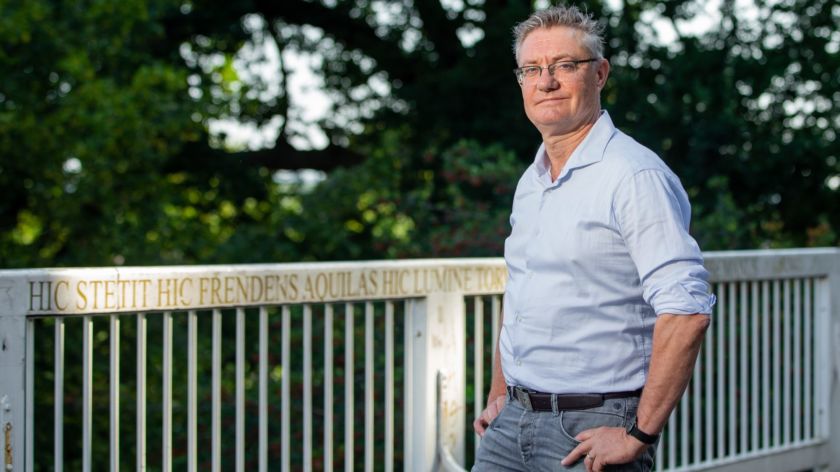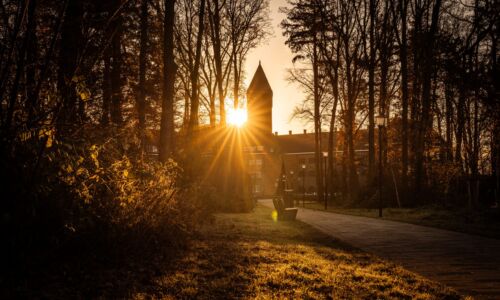‘We are the oldest city of the Netherlands – and we should show it’
-
 Stephan Mols at the Valkhof. Photo: David Van Haren
Stephan Mols at the Valkhof. Photo: David Van Haren
To make Roman Nijmegen more visible. That’s Stephan Mols’ task as the new lecturer of the history of Nijmegen. ‘To visualise above ground what lies beneath is immensely important.’
Stephan Mols is the new lecturer of the history of Nijmegen. In this function, which is financed by the municipality, his task is to make Nijmegen’s Roman past more visible. His focus will thereby be primarily on the Roman Limes, the border of the Roman empire in which Nijmegen played an important part (see column below, ed.) and which has been named a UNESCO world heritage site this summer.
The Roman Limes is in good company: among others, the Mont-Saint-Michel in France and the Great Barrier Reef in Australia as well as the Easter Island are also on the list. A great honour, but Nijmegen’s Roman past is not easy to find.
Mols is eager to change this, he says in his office on the fifth floor of the Erasmus building. ‘I first want to get in touch with different groups and people who are researching the Roman Nijmegen. After that, we can determine our next steps.’
Chair Roman history
The chair of the History of Nijmegen is a position for one day per week for three years, financed by the municipality of Nijmegen. Stephan Mols is the successor of Dolly Verhoeven, who held the chair for almost twelve years.
The Roman Limes is a world heritage site, but it’s not visible within the city. There was recently a critical piece about this in de Volkskrant.
That was a harsh article, but it’s valid criticism. When you are walking through Nijmegen right now, it’s hard to get an idea what this world heritage site is supposed to be. That’s something I want to tackle through starting a conversation with the archaeological office of the municipality, the Valkhof museum, the Bastei and the inhabitants of the residential areas with a Roman history.’
Where was the Limes in Nijmegen?
‘The military sites that formed the Limes were on the moraine. During the time of emperor Augustus, around the year zero, there was a large military site on the Hunnerberg. During the Flavian Period, around circa 70 or 80 after Christ, there was a smaller camp on the same spot, just on the Kops Plateau. And during the late third and the early fourth century, there was a military camp on the Kelfkensbos and the Valkhof. This then grew into the later, medieval Nijmegen.’

‘Some remains of the Roman history are visible in Nijmegen-Oost, such as an amphitheatre in the street pattern of the Schildersbuurt. And some pavement spots in Nijmegen-West are pointing towards the Roman city that used to be there, including two temples on the Maasplein. But this is still too little. We are the oldest city of the Netherlands – and we should show it.’
How are you planning to do that?
‘Through encouraging more people to publish about all the Roman remains that have been excavated in Nijmegen – that has not always been the case in the past. There will be a large depot on the Nieuwe Dukenburgseweg and the old Museum Kam will be made into an archaeological study centre. That’s a place that researchers that want to publish about Nijmegen can go to. Additionally, we are also doing our own research focussing on Nijmegen and its direct and greater surroundings.’
Thinktank
Mols originally comes from Tilburg, but has lived in Nijmegen for a long time. During his archaeology study, he was part of a team excavating at the Voorstadslaan in Nijmegen-West during the 1980s. ‘At one point, we came across a large Roman tomb’, he tells. ‘That later became one of the centrepieces at the Valkhof museum.’
The Roman history of Nijmegen-West is close to Mols’ heart. ‘I want to use history to connect that neighbourhood’, he says. ‘How? That’s something we’re going to work on in a thinktank during the upcoming months. But I can already say that information boards will be placed all over the city with references to the UNESCO world heritage – the current signs are not always easy to find. To visualise above ground what lies beneath is immensely important.’
‘I want to use history to connect Nijmegen-West’
Why will there be no Roman amphitheatres or temples built in Nijmegen, like at the Archeologische Park in Xanten? A few years ago, there were talks about rebuilding a keep, but that never went through.
‘I’m not in favour of rebuilding. You can visualise history in a lot of ways. Take the current street plan of Nijmegen. There you can still find a lot of Roman streets. There was, for example, a Roman street from Cuijk to Nijmegen that went across the campus, behind the Elinor Ostrom building and along the Driehuizerweg and the Toernooiveld, and in a straight line to the Valkhof. A drone can make the full route of a way like this visible. Or you could develop an app that shows how a way like that used to look like.’
Roman Limes
The Roman Limes, the border of the Roman Empire, ran from Katwijk-aan-Zee along the south of the Rhine and Danube to the Middle East and via Jordan to Morocco. ‘There was a large military camp in Nijmegen and a number of smaller ones along the Rhine’, says Stephan Mols. ‘Next to Nijmegen, there were also military camps in Xanten, in Neuss and in Cologne, the capital of the province Germania Inferor or Lower-Germany. On top of being the site of a large military camp, Nijmegen was also used as the administrative centre of the Limes.’



